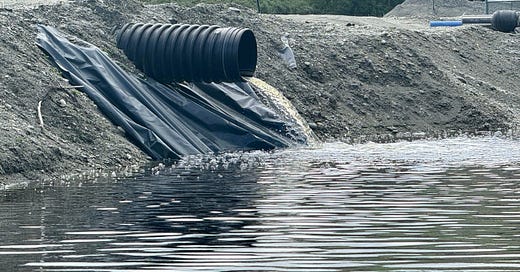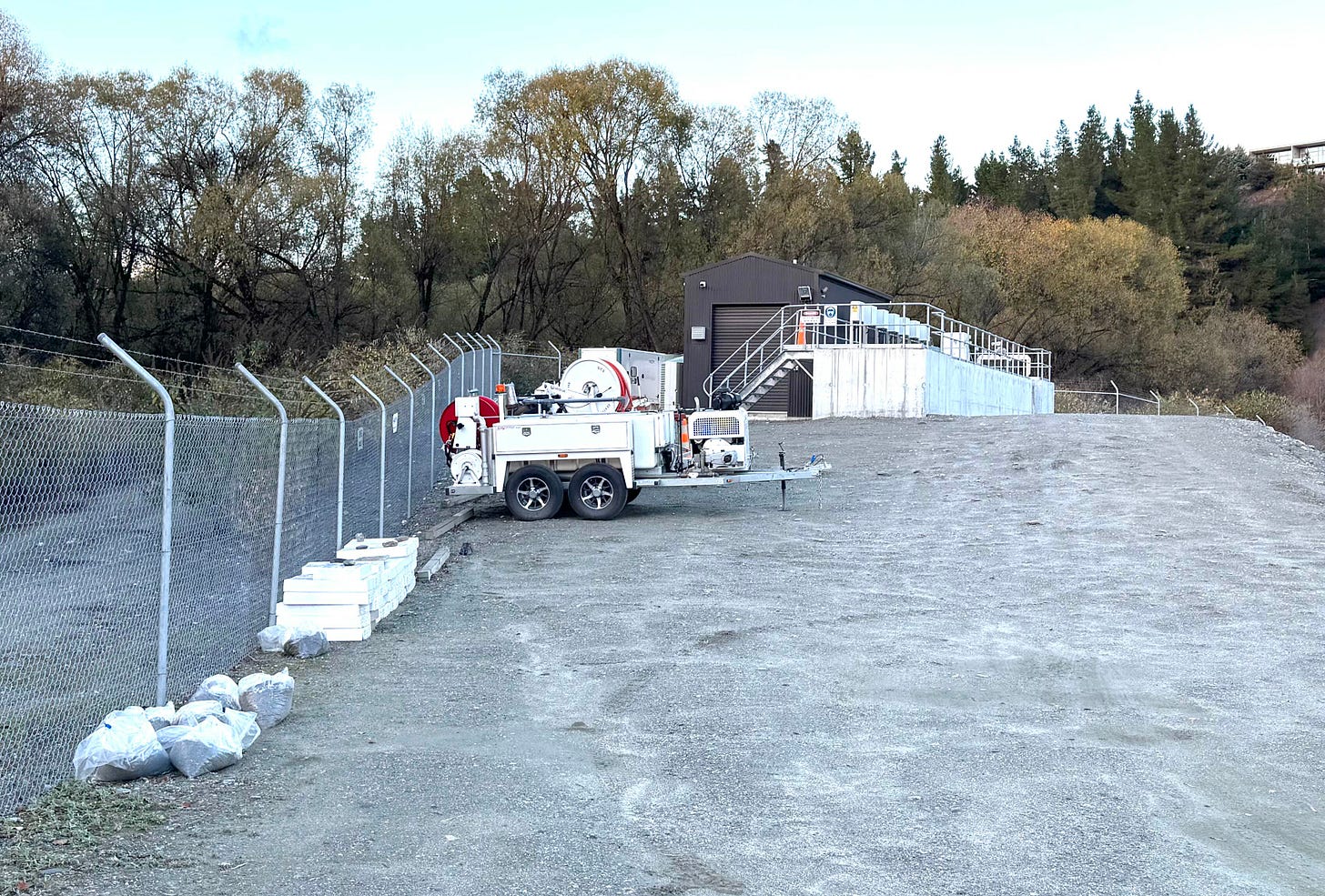Further evidence of QLDC manipulating sewage test results
Crux plans formal complaints over misleading council media releases
Thanks to our paid subscribers for funding this story. 50 likes (below) will allow us to publish this story on the Crux website for everyone to read. If you are free subscriber maybe this is the day to upgrade to paid.
A Crux Investigation.
Three key pieces of evidence have emerged this week that point to more manipulated sewage test results and misinformation that threaten public health, open local government and local democracy.
Around 1.4 million litres of effluent that’s been discharged into the Shotover River in the first two weeks of April while Shotover sewage plant treatment mechanisms were not working.
More QLDC sewage test samples that have been “lost” for almost 24 hours before being submitted for testing.
A claim from QLDC that a discharge of raw sewage this week into Lake Whakatipu was “within permitted limits” when the CEO of the Otago Regional Council has confirmed to Crux that the QLDC has no such consent.
April 2025. Multiple failures within the Shotover plant’s UV building.
The UV (or ultraviolet light) building (above) is the final stage of the Shotover sewage treatment plant. It exposes clear effluent to UV light to kill organisms such as e coli and generally sterilise the final discharge so it is safe to enter a disposal field - or potentially a river.
Clear effluent is the key to this process working. As with drinking water, if the water is cloudy or turbid, the UV light can’t do its job.
That’s how Crux discovered that the first nationwide media releases from QLDC claiming “clean safe effluent” on the first day of the emergency discharges were not accurate. Using official information legislation we discovered that while the effluent coming out of the UV building might have been clean at the time of testing, the effluent in oxidation pond 3 was high in e coli and suspended solids. In other words it was dirty and cloudy and did not go through the UV building.
We figured the pond water can’t have been released into the UV building as the suspended solids would have rendered the process useless. So, as the QLDC eventually admitted to Crux, the highly publicised “first day” samples were not representative of normal operations.
The tested water was coming from the recently commissioned clarifier tank, but usually the effluent going into the UV building is a mix of clarifier and oxidation pond, both are a part of the current sewage treatment process.
The nation’s media were told that the discharge into the Shotover was clean and highly treated. Crux will be asking for those QLDC media releases to be retracted and corrected.
Accessing even more detailed information obtained using official information legislation we got hold of the UV buildings technical records. These showed a number of times when the UV function did not work. This was when the turbidity or cloudiness of the effluent was very high.
Adding together these “non-functional” periods with the flow rate of the effluent we came up with these results (below). This is when cloudy water stopped the UV process from working and we used the logic that the cloudy (less treated) water must have come from oxidation pond 3 and gone through the UV building into the Shotover River.
31 Mar - 247,523 litres
1 Apr - 250,271 litres
2 Apr - 521,331 litres
16 Apr - 451,717 litres
There were a number of anomalies in the data supplied to Crux so this is just the first of a number of stories digging into the results..
As reported by Crux, it looks as though the QLDC is managing their water testing to coincide with times when Pond 3 is turned off. That’s an artificial and non representative result. We’ve asked for records that will allow us to study this in more detail.
Another “missing day” water sample.
We’ve reported previously on how the key “first day” effluent test sample was taken at midnight on March 31st and then “corrected” by QLDC to 9.00 am - blamed on an incorrect paperwork entry and a claim that 9.00 am was written on the sample bottle (no evidence supplied).
But that sample, that needs to be tested for e coli within 24 hours, and kept in controlled conditions under a “chain of custody” protocol, was not received by the lab (Eurofins Invercargill) until 8.30 am the following day - April 1st.
The QLDC’s infrastructure manager Simon Mason told us this:
“Our understanding is that the sample was collected 9am from the Shotover WWTP and received in the Invercargill lab at 8.30am the following day. We acknowledge this is close to the maximum allowable timing between sampling and analysis being commenced, and we have spoken to the team to encourage samples being taken later in the day to avoid this risk. Please note that this was not a compliance sample as required under the consent.”
Usually water samples are delivered to the Queenstown office of Eurofins which shares the same building as the QLDC’s sewage operator Veolia. Eurofins then courier the samples to Invercargill to arrive mid afternoon on the same day.
So we still don’t know why this 9.00 am March 31st sample was delivered to Eurofins Invercargill at 8.30 am the next day. It makes no sense and our questions on this point have not been answered by Simon Mason.
But then we discovered the following water test paperwork on Facebook that was part of another QLDC official information request (not ours).
The sample was taken at 9.00 am on April 8th, 2025 but not delivered to Eurofins Invercargill until 8.30 am the next day, April the 9th. The same collection times, and the same 23.5 hour delay, as we discovered on March 31st.
Eurofins have declined to comment on this saying it is a matter for their customer - QLDC/Veolia. Veolia has consistently refused to supply Crux with any comment on the sewage crisis.
Certainly for Crux effluent samples we need to get the samples to Eurofins Queenstown within around 60 minutes of collection. In our view, if we turned up at Eurofins Invercargill at 8.30 am the next day the sample would be have been rejected by the lab supervisor for temperature, chain of custody and e coli testing limit reasons.
The council unwittingly confirmed this to Crux only hours before this story was published (Friday May 23) when we pushed for the “permissible levels” test results from a raw sewage spill into the Frankton Arm of Lake Wakatipu on Monday May 19th.
Note the sample and reception times - all less than 60 minutes.
We will continue to push for answers as to why there is a missing day in QLDC’s Shotover sewage water test results.
QLDC’s wrongful claim of “permitted limits” for raw sewage discharge
When the QLDC disclosed a raw sewage spill into the Frankton Arm of Lake Wakatipu on Monday May 19th they claimed it had only lasted for five minutes (later changed to two minutes) and had only involved 1,000 litres (later changed to 2,000 litres).
Experts who spoke with Crux estimated the spill at up to 55,000 litres.
The QLDC also made this statement on Wednesday May 21st.
“We’re confident results from today, that we expect to receive tomorrow (Thursday), will be within permitted limits.”
It seemed very odd that the council could somehow predict what the results would be but even more strange was that they would claim that they somehow had permission to discharge raw sewage into the lake (permitted limits).
Sewage pipes on the Frankton Track - being repaired by Veolia.
The CEO of the Otago Regional Council then answered a question from Crux today with the following statement.
“I can confirm that QLDC does not hold a consent from ORC for the discharge of untreated wastewater into the lake.”
Richard Saunders. CEO, Otago Regional Council Friday May 23.
QLDC won’t tell us any more about the Frankton raw sewage spill as its currently being investigated.
We pointed out that they just need to ask Veolia who were involved in the spill (already done on Monday), and then tell us what happened.
Simple - we think so.
This is a good time to mention that we have an official information request for the QLDC’s new trust and confidence survey results (which closed at the end of March) - due Monday May 26th. The council says they won’t release the results until a council workshop on June 17.
We also asked the Chief Ombudsman when he would release the results of a three month investigation in late 2024 into the QLDC’s handling of official information requests.
This was the response from the Office of Chief Ombudsman.
“While we don’t have a specific date to give you, the report is at provisional stage and final comments are currently being sought from the Council by the Chief Ombudsman.”
Thanks to paid subscribers for funding this story. 50 likes will allow us to publish this story on the Crux website for everyone to read. If you are free subscriber maybe this is the day to upgrade from free to paid.









Great job Crux…QLDC elections cant cone soon enough… am totally disgusted at the level of secrecy and lack of honesty and integrity shown by the majority of QLDC councillors and Mayor. Certainly not living by their iinital election promises to us are they?
Good work Crux !!